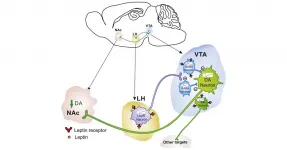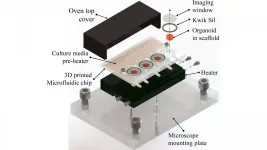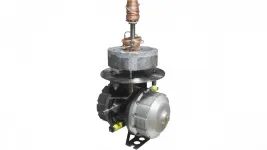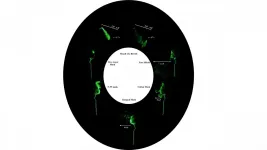The sea urchin microbiome
Researchers begin to decipher the composition and function of sea urchin microbiomes
2021-04-06
(Press-News.org) Sea urchins receive a lot of attention in California. Red urchins support a thriving fishery, while their purple cousins are often blamed for mowing down kelp forests to create urchin barrens. Yet for all the notice we pay them, we know surprisingly little about the microbiomes that support these spiny species.
Researchers at UC Santa Barbara led by geneticist Paige Miller sought to uncover the diversity within the guts of these important kelp forest inhabitants. Their results reveal significant differences between the microbiota of the two species, as well as between individuals living in different habitats. The study, which appears in Limnology and Oceanography Letters, represents the first step in understanding the function of urchins' microbial communities, including the possibility that urchins may be able to 'farm' microbes in their guts to create their own food sources.
California hosts two common species of sea urchin: red and purple. They generally consume algae, but are actually fairly opportunistic omnivores that will eat decaying plant and animal matter, microbial mats and even other urchins if need be. The microbiome in their guts might help urchins handle such a varied diet, but it hasn't been examined until now.
"It's very important to understand what animals eat and why," Miller said, "and we think the microbiome could play an important role in why species thrive despite all the variation in food availability that's out there in the ocean." However, scientists are only beginning to investigate the microbiota of ocean animals, let alone the function these microorganisms serve in their hosts.
To begin their investigation, Miller and her team collected red and purple urchins from three habitats in the Santa Barbara Channel. Some came from lush kelp forests; others from urchin barrens; and a few came from one of the channel's many hydrocarbon seeps, where they scratch a living feeding on mats of microbes that thrive off of petroleum compounds.
Key to this study's success was the researchers' stringent protocol. They used meticulous techniques to remove each specimen's stomach and guts in order to avoid contamination from microbes in the lab, elsewhere on the animal, and even in the sea water.
The researchers were then able to sequence a particular region of the genetic code that scientists commonly use to identify microbes. This enabled them to compare what they found with several comprehensive taxonomic databases that scientists use for genetic identification of microbial life.
The team found significant differences between the bacterial communities living within the two urchin species. However, they saw just as much variation between the microbiomes of individuals from the same species living in different habitats.
Purple sea urchin closeup
Comparing the microbiome of purple (pictured) and red sea urchins points toward differences between the similar species.
Photo Credit: KATIE DAVIS
"Our study is the first to examine the microbiome in these extremely common, and really ecologically important, species," said coauthor Robert (Bob) Miller, a researcher at the university's Marine Science Institute. "We're just scratching the surface here, but our study shows how complex these communities are."
One group of bacteria that was prevalent in both species is the same group that helps break down wood in the guts of termites, and could help the urchins digest algae. Previous research indicates that these microbes could potentially be autotrophic. "Some members of this group can create their own food, like photosynthetic plants, for example," explained Paige Miller, "only they don't use sunlight for energy, they use hydrogen."
Although the authors caution against jumping to conclusions, ascertaining whether urchins can produce their own food would be a huge revelation. "We know that the urchins can survive a long time without food," Bob Miller said. "And they can survive almost indefinitely in these barren areas that have very low food supplies. So, this could really help them out, if they have their own little farmed food supply in their gut."
The findings also stress the oversight of conflating these similar species. People often treat species like the red and purple sea urchins as equivalent when making decisions about resource use and management, Paige Miller explained. Even ecologists can fall into this line of reasoning. "But it's very important to look at how these things actually function," she noted. "And as we saw, the red and purple sea urchins are not necessarily functioning the same way, or eating the same things, if their microbiome is an indicator."
Understanding the makeup and function of microbiota could help researchers recognize the subtle differences between superficially similar species. "More recently, people have begun considering the microbiome as another trait that these species have," Bob Miller said. "We wanted to find out whether this is a hidden source of variation that's separating these two species."
This study provides a launch point for additional research. In the future, the Millers and their coauthors plan to further investigate the function of the different microbes in urchin guts. For now, there's still more work to do simply identifying what species reside in the prickly critters.
"This is a new subfield of ecology," said Paige Miller, "trying to understand what these microbiomes do and the role they play in the living organism out in the wild."
INFORMATION:
ELSE PRESS RELEASES FROM THIS DATE:
2021-04-06
Philadelphia, April 6, 2021 - Since the discovery of leptin in the 1990s, researchers have wondered, how does leptin, a hormone made by body fat, suppress appetite? Despite tremendous gains in the intervening three decades, many questions still remain. Now, a new study in mice describes novel neurocircuitry between midbrain structures that control feeding behaviors that are under modulatory control by leptin. The study appears in Biological Psychiatry, published by Elsevier.
John Krystal, MD, Editor of Biological Psychiatry, said of the findings, "Omrani and colleagues shed light on how, in non-obese animals, leptin puts the brakes on overeating."
Leptin acts as a critical link between the body and the brain, providing information about metabolic ...
2021-04-06
In addition to smoothing out wrinkles, researchers have found that the drug Botox can reveal the inner workings of the brain. A new study used it to show that feedback from individual nerve cells controls the release of dopamine, a chemical messenger involved in motivation, memory, and movement.
Such "self-regulation," the researchers say, stands in contrast to the widely held view that the release of dopamine -- known as the "feel good" hormone -- by any cell relied on messages from nearby cells to recognize that it is releasing too much of the hormone.
Led by researchers at NYU Grossman School of Medicine, ...
2021-04-06
WASHINGTON, April 6, 2021 -- Scientists from MIT and the Indian Institute of Technology Madras have grown small amounts of self-organizing brain tissue, known as organoids, in a tiny 3D-printed system that allows observation while they grow and develop. The work is reported in Biomicrofluidics, by AIP Publishing.
Current technology for real-time observation of growing organoids involves the use of commercial culture dishes with many wells in a glass-bottomed plate placed under a microscope. The plates are costly and only compatible with specific microscopes. They do not allow for the flow or replenishment of a nutrient medium to the growing tissue.
Recent advances have used a technique known as microfluidics, where a nutrient ...
2021-04-06
WASHINGTON, April 6, 2021 -- Cryocoolers are ultracold refrigeration units used in surgery and drug development, semiconductor fabrication, and spacecraft. They can be tubes, pumps, tabletop sizes, or larger refrigerator systems.
The regenerative heat exchanger, or regenerator, is a core component of cryocoolers. At temperatures below 10 kelvins (-441.67 degrees Fahrenheit), performance drops precipitously, with maximum regenerator loss of more than 50%.
In their paper, published in Applied Physics Letters, by AIP Publishing, researchers at the University of Chinese Academy of Sciences used ...
2021-04-06
WASHINGTON, April 6, 2021 -- Dragonfly wings, lotus leaves, cicada wings -- thanks to millennia of evolution, nature has optimized the ways these surfaces and others behave to offer antibacterial functionality.
An international, interdisciplinary team of researchers is trying to find the best way to translate these features to create nature-inspired bactericidal surfaces for use in medical implants. They discuss the surface structures and chemical compositions for an ideal implant material in the journal Applied Physics Reviews, from AIP Publishing.
"Objects in ...
2021-04-06
What The Study Did: Researchers compared the effectiveness of case-based (including contact tracing and quarantine) and population-based (including social distancing and facial masking) interventions for COVID-19 containment in Taiwan, one of the few countries with initial success in COVID-19 control without strict lockdown or school closure.
Authors: Hsien-Ho Lin, M.D., Sc.D., of National Taiwan University in Taipei, Taiwan, is the corresponding author.
To access the embargoed study: Visit our For The Media website at this link https://media.jamanetwork.com/
(doi:10.1001/jamainternmed.2021.1644)
Editor's Note: The article includes conflicts of interest and funding/support disclosures. Please see the article for additional information, including ...
2021-04-06
What The Study Did: This study investigated the role of droplet or contact transmission in the development of Kawasaki disease in Japan during the COVID-19 state of emergency. Kawasaki disease primarily affects children and is characterized by fever and swelling in the walls of some blood vessels.
Authors: Toshiro Hara, M.D., Ph.D., of the Fukuoka Children's Hospital in Fukuoka, Japan, is the corresponding author.
To access the embargoed study: Visit our For The Media website at this link https://media.jamanetwork.com/
(doi:10.1001/jamanetworkopen.2021.4475)
Editor's Note: The article includes conflicts of interest and funding/support disclosures. Please see the article for additional information, ...
2021-04-06
What The Study Did: A model to prioritize vaccination was developed that estimates the risk of SARS-CoV-2-related death among enrollees in the Veterans Affairs health care system.
Authors: George N. Ioannou, B.M.B.Ch., M.S., of the Veterans Affairs Puget Sound Healthcare System in Seattle, is the corresponding author.
To access the embargoed study: Visit our For The Media website at this link https://media.jamanetwork.com/
(doi:10.1001/jamanetworkopen.2021.4347)
Editor's Note: The article includes conflicts of interest and funding/support disclosures. Please see the article for additional information, including other authors, author contributions and affiliations, conflict of interest and financial disclosures, and funding and support.
INFORMATION:
Media ...
2021-04-06
What The Study Did: The clinical and other characteristics of multisystem inflammatory syndrome in children in the United States, a condition that occurs in association with the COVID-19 pandemic, are described in this study.
Authors: Ermias D. Belay, M.D., of the Centers for Disease Control and Prevention in Atlanta, is the corresponding author.
To access the embargoed study: Visit our For The Media website at this link https://media.jamanetwork.com/
(doi:10.1001/jamapediatrics.2021.0630)
Editor's Note: The article includes conflict of interest ...
2021-04-06
WASHINGTON, April 6, 2021 -- With research increasingly showing the COVID-19 virus is transmissible via smaller droplets suspended in air, there is a growing concern current public health guidelines of mask wearing and social distancing are insufficient in combating its spread in indoor environments, like prisons, hospitals, and meatpacking plants, where people tend to be in close quarters.
Most research has focused on coughing and sneezing. But studies on how simply breathing might contribute to airborne spread of the virus are rare.
In AIP Advances, by AIP Publishing, researchers at the Indian Institute of Technology Bhubaneswar show social distancing is equally ...
LAST 30 PRESS RELEASES:
[Press-News.org] The sea urchin microbiome
Researchers begin to decipher the composition and function of sea urchin microbiomes



